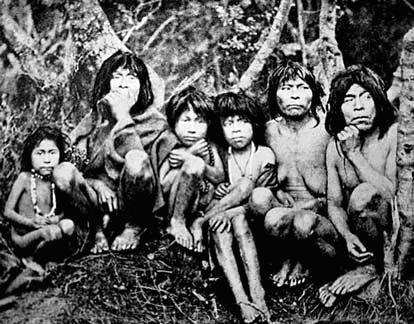YAGHANLAR

Bir Yaghan ailesi. Pedro Martinez/South American Pictures Living at the extreme southern tip of South America, the Yahgan people subsisted primarily on shellfish and marine animals. Despite the cold, damp climate, they wore little clothing. This Yahgan family was photographed in the late 19th century; by the mid-20th century their culture was extinct.
In 1520, the territory known today as the Tierra del Fuego was founded by a man named Ferdinand Magellan. Through these terrains is a place called the Fuegian Archipelago, and in this area lived a civilization of tribes: the Yahgans, the Alacaluf, and the Onas. Each tribe was linked together with many similarities, but attributed to their own distinct ways of life and living among their own tribal members. The Yahgan Indians lived south of the other two tribes and was most commonly known as the Canoe Indians. In the book, Bureau of American Ethnology, the Yahgan Indian territories were the shores of the Beagle Channel and the islands of Cape Horn. The name Canoe Indian came from spending most of their time on the water. The Yahgans and the Alacalufs territories were very close to each other next to the Beagle Channel, so bartering and intermarriages were very common. However, just because they were close in territories, doesn't mean that they were similar in languages. The Yahgan language is known as Lexically. The Yahgan language is quite distinct from both the Alacalufan and the Onan (Cooper 4), however the Yahgan dialect has been borrowed from the other tribes in the surrounding areas. The religion is fairly simple to understand. Rev. Bridges states: the Yahgans have no Supreme Deity, God, or Creator, nor any word in their language for such (148). The Rev. also says: ...the Yahgan supposes the sun and moon, male and female, to be very old indeed, and that some old man, who knew their maker, had died, without leaving information upon his subject (148). They do not believe in a supreme deity, but they do have a good and an evil spirit that lives among the tribe. Just like our civilization, the Yahgans also have rituals that they live by. When a member of the Yahgan Indians die, they are interred or cremated, their family members mourn the death by praying by the burial site (which is placed far away from the tribal territory) all day. Their loved one's belongings are either given away or destroyed instead of buried with the body.
|
The birth of a child in the Yahgan Tribe is an occasion to celebrate with many rituals. When the child is born, the umbilical cord is cut with a sea shell; and then, the cord and the placenta from the womb are both burned. The mother and the child are both brought to the sea and bathed; the belief is that after the child is born they bath it in the sea for strength. As with many tribes, ceremonies are held to mark the initiation of important customs among the tribe. For instance, an adolescent boy is put to a physical and psychical test to prove his endurance, honesty, bravery, and to learn the laws of marriage. When the boy has proven himself to the tribe, he is told the truth about the spirits. Cooper says in his book: ... he is threatened with dire punishment if he should ever reveal the secrets to the women or children (156). When we first discovered the Yahgan Indians, their population was about 3,000, and now there is less than 100 natives left, and only 40-50 still live in their native territory. Their ways of life have been forgotten with the aging society and those that still live have given up most of their native culture entirely.
References: Cooper, John. Bureau of American Ethnology. Washington: Government Printing Office, 1917. Patagonian Adventure. Smithsonian Study Tours (21 June 2001) http://smithsonianstudytours.si.edu/sst/international/110302patagonia.htm (1 March 2003). Written by Jennifer Spielman, 2003 |
|